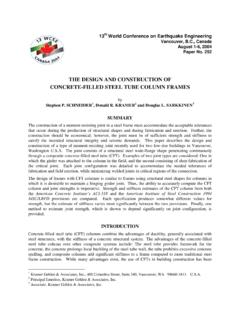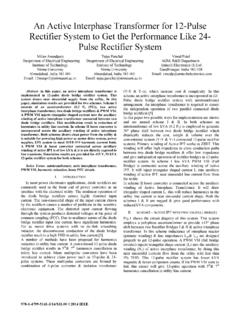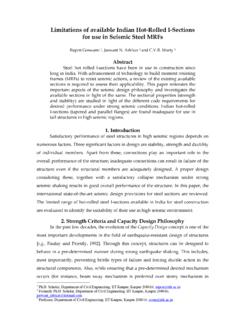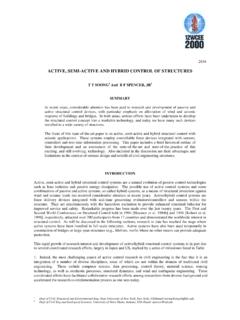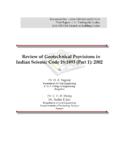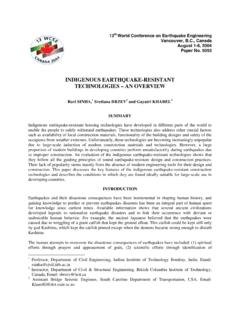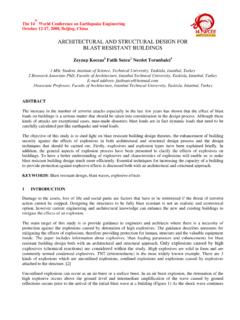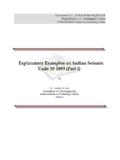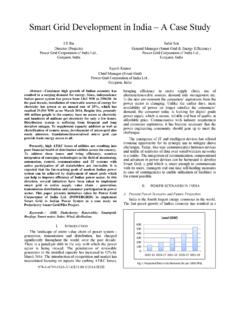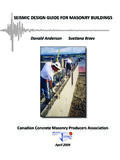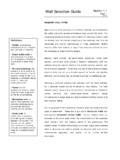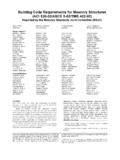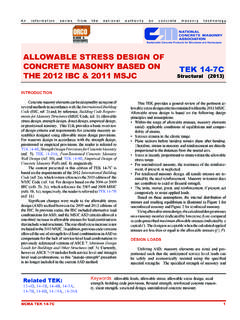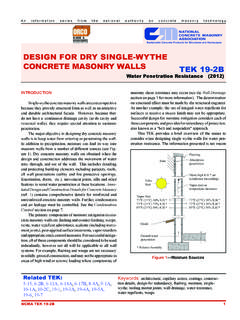Transcription of Material Characterization for Masonry Structures - …
1 Material Characterization for Masonry StructuresMr. Syed Humayun BashaIndian Institute of Technology GuwahatiIITG Workshop onEarthquake Resistance of Low-Cost Engineered H ousing in North-East IndiaDr. Vaibhav SinghalIndian Institute of Technology Patna Proper Material Characterization required for load bearing and non-load bearing Masonry Load Bearing unreinforced and reinforced Masonry Confined Masonry Non-load Bearing unreinforced and reinforced masonryMaterial Characterization for Masonry2 Masonry Brick or Block unit Mortar Clay Bricks Most Common Two types of Un-burnt Burnt Fly ash Bricks Hollow Clay Bricks Concrete Blocks (Solid and Hollow) Autoclaved Aerated Concrete (AAC) Blocks Cellular Light weight Concrete (CLC) BlocksTypes of Brick/Blocks3 Characterization of Brick Units4 Material Properties Water Absorption (WA) Initial Rate of Absorption (IRA)
2 Mortar bond strength Important to assist in mortar selection and Material handling Compressive strength (fb) Tensile strength Flat Position On edgeCharacterization of Brick FieldTests VisualInspection:Brickwhenbrokenshouldbe homogeneousinstructure,compactandfreefro mholes,lumps,pebblesandparticlesoflimeet c. Colourofa goodbrickshouldbecopperred. Yellowishtintonbrickindicatesthatbrickun derburntandposseslowstrength If brickis ofdarkblackishbluecolourit indicatesthebrickis of Brick Uniformsizeandshape:Bricksshallbeofunifo rmsizeandshape, withoutanybrokenedgesandcorners. Edgesshouldbesharpandstraightanddimensio nvariationlimitedto3mm. RingingSoundtest:Whentwobricksstrucktoge ther,thereshouldbeclearmetallicringingso und. Droptestforstrengthcheck:Abrickshouldnot breakwhendroppedflatonhardgroundfroma heightofaboutonemeter.
3 Of Brick Water Absorption and Initial Rate of Absorption Gives information about quality of bricksWA: Water Absorption capacity of the brick materialIRA: Suction of water from mortar due to capillary action in bricks (per minute, per unit area, brick immersed in about 3 mm deep water) Characterization of Brick Water Absorption and Initial Rate of Absorption Gives information about quality of bricksWA: Water Absorption capacity of the brick materialCharacterization of Brick Water Absorption and Initial Rate of Absorption Gives information about quality of bricksWA: Water Absorption capacity of the brick Material IS 3495 -24-hour Immersion Cold Water Test ASTM C67 -5-hour and 24- hour Immersion Tests1-h, 2-h and 5-h Boiling TestsCharacterization of Brick Water Absorption and Initial Rate of Absorption Gives information about quality of bricksIRA: Suction of water from mortar due to capillary action in bricks (per minute, per unit area, brick immersed in about 3 mm deep water) ASTM C67 IRA test is not mandatory as per IS:3495 (1992)!
4 !!fbWA IRAC haracterization of Brick IRA and fbare more closely correlated No limits proposed for IRA in any standards Limits to kg/m2/min provide good bond strength (Drysdale et al. 1994). Too low IRA, bricks may float on mortar Too high IRA, rapid suction of water in mortar by bricks Poor Brick-Mortar BondSource: Kaushik et al. (2007)0102030400123 IRA, kg/m2/minComp. stress, MPaCr= - , %Cr= - of Brick Compressive Strength IS 3495 Part 1: Solid, perforated Burnt Clay Bricks, Fly-ash Bricks IS 2185 Part 1: Hollow and Solid Concrete Blocks IS 6441 Part 5:Autoclaved Cellular Concrete Products IS 2185 Part 4: Preformed Foam Cellular Concrete Blocks ASTM C67-13: Testing Brick and Structural Clay TileSource: Basha and Kaushik (2015) Characterization of Brick Tensile Strength ASTM C 1006-07: Splitting Tensile Strength of Masonry unitsSource: Singhal and Rai (2014) Characterization of Mortar Compressive Strength IS 2250 1981: Preparation and use of Masonry Mortars ASTM C109/C109M-13 : Compressive strength of Hydraulic of Various grades of mortar, (cement: lime.)
5 Sand) by volume were employed in general construction practice. Compressive behavior of mortar with lime found to be better because of greater ductility. Age-old practice of using lime in mortar found to have a role in improving the performance. 15 StrainSource: Kaushik et al. (2007) Characterization of Masonry In any Masonry structure , during a seismic event its various elements/components are under the influence of a variety of actions. For instance, a Masonry wall could at any point be under a vertical compressive load, in-plane and/or out-of-plane lateral loads, etc. Important to characterize the fundamental behaviour Compression Tension Flexure Shear16 Characterization of Masonry in Compression IS 1905 recommend to determine compressive strength of Masonry by prism test.
6 Masonry prisms should be atleast 40 cm high and shall have a height to thickness ratio (h/t) of atleast 2 and not more than 5. Prisms shall be tested after 28 days between sheets of plywood by applying uniformly distributed load at a rate of 350 to 700 stack bonded prismCharacterization of Masonry in Compression If h/tratio is less than 5 and greater than 2, correction should be as per Table 12 (IS 1905).18 Characterization of Masonry in Compression19 IS 1905also recommends to calculate the permissible compressive stress based on compressive strength of brick by applying suitable reduction factors as per Table of Masonry in Tension20 TensionBondStrength:requiredformasonrywa llssubjectedtoforcesappliednormaltothefa ceofwall,suchaswind,eccentricgravityload s,andsoon.
7 Varioustestproceduresanddifferenttypesof specimenssuggestedtodeterminethetensionb ondstrength. ButIndiancoderemainssilent. Testsincludethebondwrenchtest,directtens iontest, andcrossedcouplettest, andallthetestprocedureshastheirowndrawba cksandproblems(Khalaf2005). AnewZ-shapedspecimenproposedbyKhalaf(200 5).Source: Singhal and Rai (2014) Characterization of Masonry in Flexure21 Flexure Bond Strength: During past earthquakes, out-of-plane collapse (flexural failure) of the Masonry walls were one of the predominant modes of failure. Flexural bond strength is crucial in normal as well as parallel directions to the bed-joint. Current Masonry design codes [MSJC (2011)] duly consider the flexural tensile strength in the design of Masonry in both directions.
8 BS EN 1052-2 describes the test method. Source: Singhal and Rai (2014) Characterization of Masonry in Shear22 Shear Strength Global behavior of Masonry Structures or RC infill frame Structures under seismic forces is significantly governed by the in-plane load-carrying capacity of its Masonry assemblages. Important parameter for the design of Masonry under lateral load Can be correlated with the compressive strength of masonryCharacterization of Masonry in Shear23 Shear Strength Load carried by wall in the in-plane direction depends on the shear strength of Masonry and needs to be simulated. Shear strength of Masonry can be determined from Diagonal Tension Testof Masonry wallettes in accordance with ASTM E519-08 and RILEM LUM B6.
9 The nominal size of the Masonry wallette is : Singhal and Rai (2014)Evaluation of Properties of Fly Ash Brick Masonry24 Fly Ash Bricks: Gaining importance due to easy mode of manufacturing and decreasing the emission of greenhouse gases. Characterisation of Brick UnitsWater Absorption (WA) / Initial Rate of Absorption (IRA) According to IS 12894, the WAshould not be more than 20%. Based on IRAlimits ( kg/m2/min), the bricks need to be wetted prior to Density (kg/m3)IRAC ompressive strength(%)(kg/m2/min)MPaFly ash brick (Current Study) Brick Class I (North East India) Brick Class III (North East India) Brick (North India)(Kaushik et al. 2007) Brick (North India)(Singhal and Rai 2014) Moulded Clay Brick (South India)(Gumaste et al.)
10 2007) Cut Clay Brick (South India)(Gumaste et al. 2007) Characteristics of Brick UnitsCompressivestrengthofbrickunits Codes: IS3495andASTMC67-13 MPa. Averagemodulusofelasticitywasfoundtobeab out3878 MPa., Stress (MPa) StrainSource: Basha and Kaushik (2015)Characterisation of Brick mechanisms observed in brick units27 Initiation of vertical cracks along depthCrushing of fly ash brick unitsSource: Basha and Kaushik (2015)Stress-Strain Characteristics of MortarCompressive strength of mortar Codes: IS 2250 and ASTM C109/C109M-13 Mortar found to be stiffand strongcompared to fly ash bricks28 MortarGradeCompressive strengthFailure StrainElastic ModulusMPaMPaStrong Mortar (1:3) mortar (1:4) mortar (1:6) Characteristics of of compressive behavior of mortar cubes29 Characteristics of mechanisms of mortar cubes30 Formation of vertical cracksTension break failureConicalshape failureSource.

